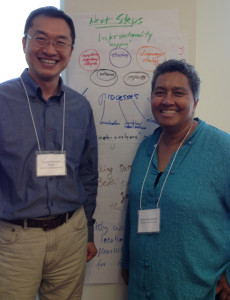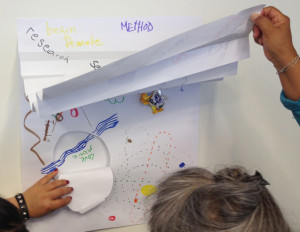Context:
Q: How many intersectionality scholars does it take to count who’s at the dinner table?
A: One Japanese waiter. (Male.)
“Be gentle.”
Charlotta’s request came toward the end of the 2nd meeting of our Working Group on Research Methods at the “Interrogating Intersectionality” conference sponsored by the Center for Gender in Organizations at the Simmons College School of Management. Charlotta was the last member of our group to present. At this point we had been engaging with each other for about 2 & 1/2 hours, and I was glad that everyone was reminded about our interaction being blogged. We had negotiated authorization during my presentation on the first day, and clarified the boundaries (of who & what might potentially be bloggable) at the start of this (2nd) session while welcoming Lisa to the group.
“I don’t have ownership of this project.”
The reason Charlotta gave for requesting a mild representation was because she had not contacted her fellow researchers regarding their opinion of her assent to being blogged. I hope her colleagues are okay with me mentioning that their research project involves “Generation Y.” This struck me as a moment of virtual intersectionality because I am in the midst of exploring collaboration with an entrepreneurial group of Gen Y glomads. I am curious what Gen X and Baby Boom era scholars can offer to a younger cohort, and equally excited by what Gen Y’ers may be able to teach us.
“All research is potentially intersectionality research.”
Samuel may have benefitted the most directly from our preview of Lisa’s panel talk but we all enjoyed her responses to his question about how to use quantitative methods to get insight into the matrix of a particular organization. “Any method can be used,” she said. “What matters is the analytical framework…to bring in what you know…. [to link] the micro and the macro.” Lisa told us about her favorite article, “Intersectionality and In-Depth Interviews” (Cuádraz and Uttal, 1999), which it seems we are all going to rush to read.
“Don’t lose sleep over methods.”
Elizabeth also received direct encouragement from Lisa. Barbara suggested Judith Lorber’s work on the paradox of having to make identity categories visible (which also reifies them) as the first step in problematizing structures of inequality. The challenge of making the invisible visible, of bringing those aspects of relationships and identities that have been silenced into awareness and open conversation, was a common problem across the seven different research projects that we explored with each other. Several of us became excited by the notion of using vignettes for our various contexts.

What if . . .
The idea of a vignette is to create a realistic scenario involving a person of particular identity characteristics dealing with a situation that is reflective of their context (i.e., the context being studied). This vignette is shared and used as a reference point during interviews. Questions evolve from (something like),
- “What do you think this person can/should do in this situation?” or “What do you think will happen to this person in this situation?” and “Why do you think ‘this’ or ‘that’ will happen?” to questions like,
- “If it was you in this situation, what do you think would happen? What would your options be?” to
- “Does comparing this situation from the perspective of people with different identity characteristics lead you to consider anything new about yourself, and/or about your relationships with others, that you hadn’t thought about before?”
Interlude:
Debra: “I’m younger than I look!” Steph: “Immaturity got me this far!”
“That reflects where we were.”

Definition from Winter and Degele:
“Intersectionality as a multi=level analysis:
Dealing with social inequality”
At the opening of the third–and last–session of our Working Group, Judith and Barbara emphasized how their focus had shifted over the course of the conference, from problems of research (as described above) to challenges of teaching. James noted that the definition of intersectionality he had shared with us on the first day uses the label of “symbolic representation” but that we–talking with each other–have not explored this very much. Frustrated with the limitations of the much-used diversity wheel, Barbara said, ”I’d love to have another symbol.” Elizabeth liked the notion of “interference” (which had been introduced by one of the keynoters) and Barbara shared a notion of “identity landscapes” developed by one of her graduate students.
Next Steps
Our group’s attempt to represent our cumulative learning/knowledge from the three day working conference sought to incorporate multiple metaphors: the simultaneity hologram, identity landscapes, gravitational planetary systems, chemical reactions, temporal change, individual representations of self, blind spots (that need to be unwrapped) and hope – - – which is my interpretation (!) of the ‘Love Picnic River’ just waiting to be revealed.

Mapping Intersectionality.
Copyright: Margo Okazawa-Rey and the Transnational Feminism Working Group.
View all posts in series Learning Resiliency
Previous in Series: Action Planning for Emergency Management Interpreting — Next in Series: The ANSWER . . . is DIRT (the question is irrelevant)










